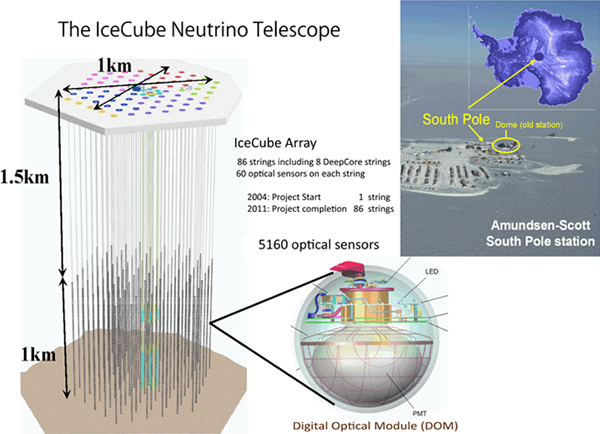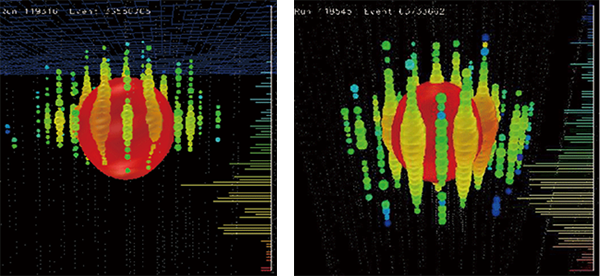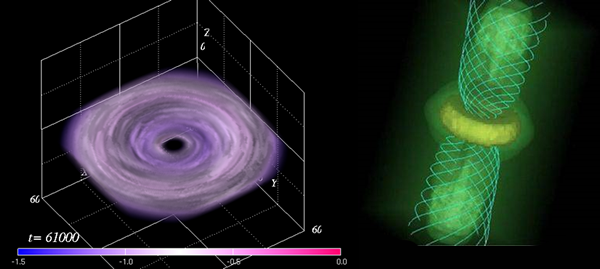The IceCube Neutrino Observatory

The IceCube Neutrino Observatory is a neutrino telescope that detects and reconstructs neutrinos at the South Pole. The detector consists of a three-dimensional array of 5,160 optical sensors, called DOMs, on 86 strings at depths between 1,450m and 2,450 m in the glacial ice beneath the geographic South Pole. The full operation started April of 2011, after completing 6 year long construction.
A charge-neutral and nearly massless subatomic particle called the neutrino is expected as a smoking gun to map ultra-high energy universe, in the energy band of PeV and beyond, 1,000,000,000,000,000 times higher than the energy of visible light. Being interacted only by "weak" force, neutrinos are travelling over cosmological distances without losing energy. Other subatomic stable particles like protons, electrons, and even photons, the representative messengers employed in astronomy, cannot penetrate our Universe at such high energies, because the cosmic microwave background (CMB), the cold relics from the Big Bang, makes our universe completely opaque in ultra-high energy region. A measurement of neutrinos secondary produced by ultra-high energy hadrons (like protons and neutrons), thus, leads to identify sources of their radiations with a good deal of precision.
The field of neutrino astronomy was first initiated by Japanese "Kamiokande" detector. It detected eleven neutrinos from the supernova 1987-A. The detection technique employed by the IceCube is the same as the Kamiokande and its successor, the Super-Kamiokande do - recording the light flash known as Cherenkov radiation emitted from rarely-occurred collisions between the neutrinos and the water/ice.
What made the IceCube so unique is its size of the detection volume.
the three-dimensional array of 5,160 optical sensors formed 1 km-cubic instrumentation volume, approximately 20,000 times larger than the Super-Kamiokande!
This incredibly giant array makes it realizable to search for ultra-high energy neutrinos with energies billion times or even higher than the neutrinos Kamiokande detected from the supernova, as such energetic neutrinos are expected to be so rare.
The members from the ICEHAP of the Chiba university has played leading roles to search for ultra-high energy neutrinos by IceCube. In 2012, the team has announced that two ultra-high energy neutrino events are observed by the fully-deployed IceCube deep ice array. Neutrino energies of two events are estimated to be 1 PeV. They are the most energetic neutrino events ever detected to the present.
The preliminary significance for a background-only (i.e., conventional atmospheric neutrinos) hypothesis is 3.1 sigma (0.09%), indicating that they are a first indication of a cosmic neutrino flux produced by very high energy cosmic rays. Our journey has just begun.

